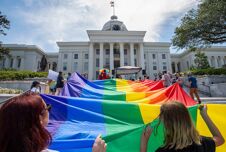On the 7th of October, as the first sunbeams touched the towns bordering Gaza, a profound tragedy unfolded – one of the most significant in the history of the Israeli-Palestinian conflict.
Observing from a place of safety, I witnessed events that gradually unraveled my preconceived notions of the evolving conflict.
Related:
Libs of TikTok connected to 11 recent school bombing threats
The woman behind the account, Chaya Raichik, has claimed that she’s merely sharing information and can’t control how people respond.
Endlessly blurred lines
Dive deeper every day
Join our newsletter for thought-provoking commentary that goes beyond the surface of LGBTQ+ issues
Free speech, by definition, is the right to express opinions without censorship. In contrast, hate speech involves abusive or threatening language based on prejudice — whether it’s ethnicity, religion, or any other grounds. In today’s digital age, the boundary between the two seems ever-evolving, especially when everyone — from individuals to bots — has a platform to voice their opinions.
Since the Palestinian-Israel conflict began, I’ve been grappling with this thin line. I’ve always striven for balance, avoiding extremes. Yet, voicing opinions online on the conflict exposed me to backlash. Regardless of its tactful delivery, no statement was considered simply free speech, neither mine nor others. Almost all viewpoints were either deemed antisemitic or Islamaphobic.
Some questioned my pro-Palestine stance based on my sexuality and asked how I could even think of supporting the same people who, if given the chance, would behead me for whom I love. This narrative, however, goes beyond just me — it emphasizes our collective challenge of comprehending diverse perspectives in a charged environment.
It’s Meta’s world
Before the advent of the digital age, our opinion was mainly kept within the realms of our close circles. Nowadays, our opinions propagate freely, and the online world is a broad and boundless space for free expression. However, it doesn’t come without challenges.
Today, we’re in the era of digital giants like Meta (Instagram, WhatsApp, Facebook). These platforms may project an image of fostering free speech, but they are not free of bias and algorithms that perpetuate the corporation’s political incline. Trending topics often dictate the discourse, and those who don’t align with these trends can be silenced. Over the past weeks, it’s been evident that online regulation isn’t just a matter of right vs. left.
We have seen, for example, how prominent social media voices like ‘Eye.on.Palestine’ (now reinstated) were silenced and accused of fostering antisemitism.
If the ever-so-thinning margin between hate and free speech weren’t enough, another issue is rising: social media bias at the regulatory level.
Maintaining fairness in our digital world is part of a more significant challenge: Balancing free speech with the need to control harmful content becomes even trickier with potential biases in how these large platforms regulate content.
Biases have always existed; I was taught in journalism school that no matter how hard you try, you will always be subject to your inclination. But this is not a single article we are discussing – it’s Meta, quite literally a social media giant.
However, the situation becomes even more complex when we consider the role of social media platforms in shaping public discourse. While offering a space for diverse voices, these platforms also wield the power to influence and, in some cases, control the narrative.
It’s clear now that hate speech vs free speech has a distinct definition in Mark Zuckerberg’s dictionary.
Accounts across the spectrum face scrutiny; this has been a hot debate in the latest developments of the Middle Eastern conflict, with some accounts being shadow-banned and others being automatically labeled ‘Palestinian terrorists’ by Instagram. But the bias and selective shadow banning is nothing new, especially for queer creators, sex workers and human rights activists.
While purporting to offer a space for free expression, these platforms often impose restrictive measures that disproportionately affect marginalized groups. This creates an uneven playing field where some voices are amplified while others are silenced or heavily monitored.
Take sex workers: They have to sensor keywords, open and close social media accounts, and find creative ways to link their Only Fans accounts. The same goes for queer creators, who get censored daily. However, there seems to be a ‘lucky’ bunch that somehow always slips through Meta’s net. One such account is Libs of TikTok.
Libs of TikTok break Meta’s rule regularly; the account’s founder, Chaya Raichik, regularly outs teachers, doctors and other professionals, causing them to receive letters of hate – or, worse, bomb threats. Case in point: an Oklahoma school district inundated with death threats after being featured on the account, and the Boston Children’s Hospital grappling with a severe bomb threat after being spotlighted.
In July 2022, Meta, together with various other platforms, announced that the use of “groomer” as a slur against the LGBTQ+ community breached their policies on hate speech. Meta reaffirmed this position, making it clear that employing the term “groomer” without justification to label LGBTQ+ individuals is against its hate speech rules. Yet, accounts using the slur, such as Gays Against Groomers (designated as an anti-LGBTQ+ extremist coalition by the Anti-Defamation League), have managed to spend thousands and thousands of dollars on advertising.
After Elon Musk took over Twitter (now X), the multibillionaire quickly dismantled the company’s Trust & Safety Council, which used to moderate Twitter’s content. Last year, the New York Times reported that slurs against Black Americans increased more than 50% since its dismantlement. At the same time, homophobic language jumped from 2,506 times a day to 3,964 times. Finally, the Antisemitic language has risen by a whopping 61%.
Where do we go from here?
Over the 21st century, the progress we have made with social media (at least in the Western hemisphere) is undeniable. We have collectively gained voices and created unique communities; We no longer need someone to represent us to express contentment or dissent; we can do it ourselves. But with great privilege comes great responsibility, one that we often overlook. The absence of that responsibility has partially led to the thinning of the border between free and hate speech. But we can’t solely blame ourselves. We are not the only culprits.
X and Meta must have a bias check-in; if we wish to continue perpetuating a world where free speech and hate speech seamlessly blend into a free-for-all land, then the freedom to speak must be equal for all parties involved. On the contrary, if we prefer to trot down the paved road of balanced speech, then one party more than the other must be reined in. If a sex worker can lose their income to Meta’s shadow banning, I don’t see why the freedom granted to Libs of TikTok should result in a children’s hospital showered in bomb threats.
As we navigate these tumultuous times, we must constantly evaluate and re-evaluate our biases, beliefs, and the platforms that amplify our voices, never taking for granted the voice that once belonged to the few.
















Social media brands have proven incapable of determining what is & isn’t hate speech